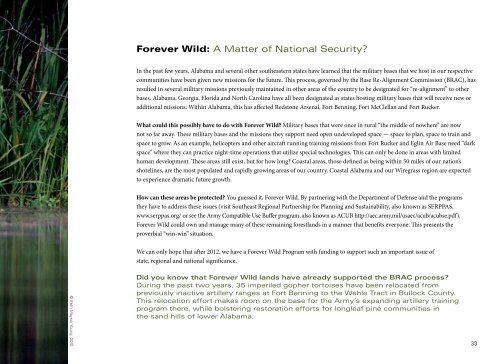The Forever Wild Land Trust - Alabama Department of Conservation ...
The Forever Wild Land Trust - Alabama Department of Conservation ...
The Forever Wild Land Trust - Alabama Department of Conservation ...
You also want an ePaper? Increase the reach of your titles
YUMPU automatically turns print PDFs into web optimized ePapers that Google loves.
<strong>Forever</strong> <strong>Wild</strong>: A Matter <strong>of</strong> National Security?<br />
In the past few years, <strong>Alabama</strong> and several other southeastern states have learned that the military bases that we host in our respective<br />
communities have been given new missions for the future. This process, governed by the Base Re-Alignment Commission (BRAC), has<br />
resulted in several military missions previously maintained in other areas <strong>of</strong> the country to be designated for “re-alignment” to other<br />
bases. <strong>Alabama</strong>, Georgia, Florida and North Carolina have all been designated as states hosting military bases that will receive new or<br />
additional missions. Within <strong>Alabama</strong>, this has affected Redstone Arsenal, Fort Benning, Fort McClellan and Fort Rucker.<br />
What could this possibly have to do with <strong>Forever</strong> <strong>Wild</strong>? Military bases that were once in rural “the middle <strong>of</strong> nowhere” are now<br />
not so far away. <strong>The</strong>se military bases and the missions they support need open undeveloped space — space to plan, space to train and<br />
space to grow. As an example, helicopters and other aircraft running training missions from Fort Rucker and Eglin Air Base need “dark<br />
space” where they can practice night-time operations that utilize special technologies. This can only be done in areas with limited<br />
human development. <strong>The</strong>se areas still exist, but for how long? Coastal areas, those defined as being within 50 miles <strong>of</strong> our nation’s<br />
shorelines, are the most populated and rapidly growing areas <strong>of</strong> our country. Coastal <strong>Alabama</strong> and our Wiregrass region are expected<br />
to experience dramatic future growth.<br />
How can these areas be protected? You guessed it, <strong>Forever</strong> <strong>Wild</strong>. By partnering with the <strong>Department</strong> <strong>of</strong> Defense and the programs<br />
they have to address these issues (visit Southeast Regional Partnership for Planning and Sustainability, also known as SERPPAS,<br />
www.serppas.org/ or see the Army Compatible Use Buffer program, also known as ACUB http://aec.army.mil/usaec/acub/acubse.pdf),<br />
<strong>Forever</strong> <strong>Wild</strong> could own and manage many <strong>of</strong> these remaining forestlands in a manner that benefits everyone. This presents the<br />
proverbial “win-win” situation.<br />
We can only hope that after 2012, we have a <strong>Forever</strong> <strong>Wild</strong> Program with funding to support such an important issue <strong>of</strong><br />
state, regional and national significance.<br />
© Beth Maynor Young, 2010<br />
Did you know that <strong>Forever</strong> <strong>Wild</strong> lands have already supported the BRAC process?<br />
During the past two years, 35 imperiled gopher tortoises have been relocated from<br />
previously inactive artillery ranges at Fort Benning to the Wehle Tract in Bullock County.<br />
This relocation effort makes room on the base for the Army’s expanding artillery training<br />
program there, while bolstering restoration efforts for longleaf pine communities in<br />
the sand hills <strong>of</strong> lower <strong>Alabama</strong>.<br />
33

















